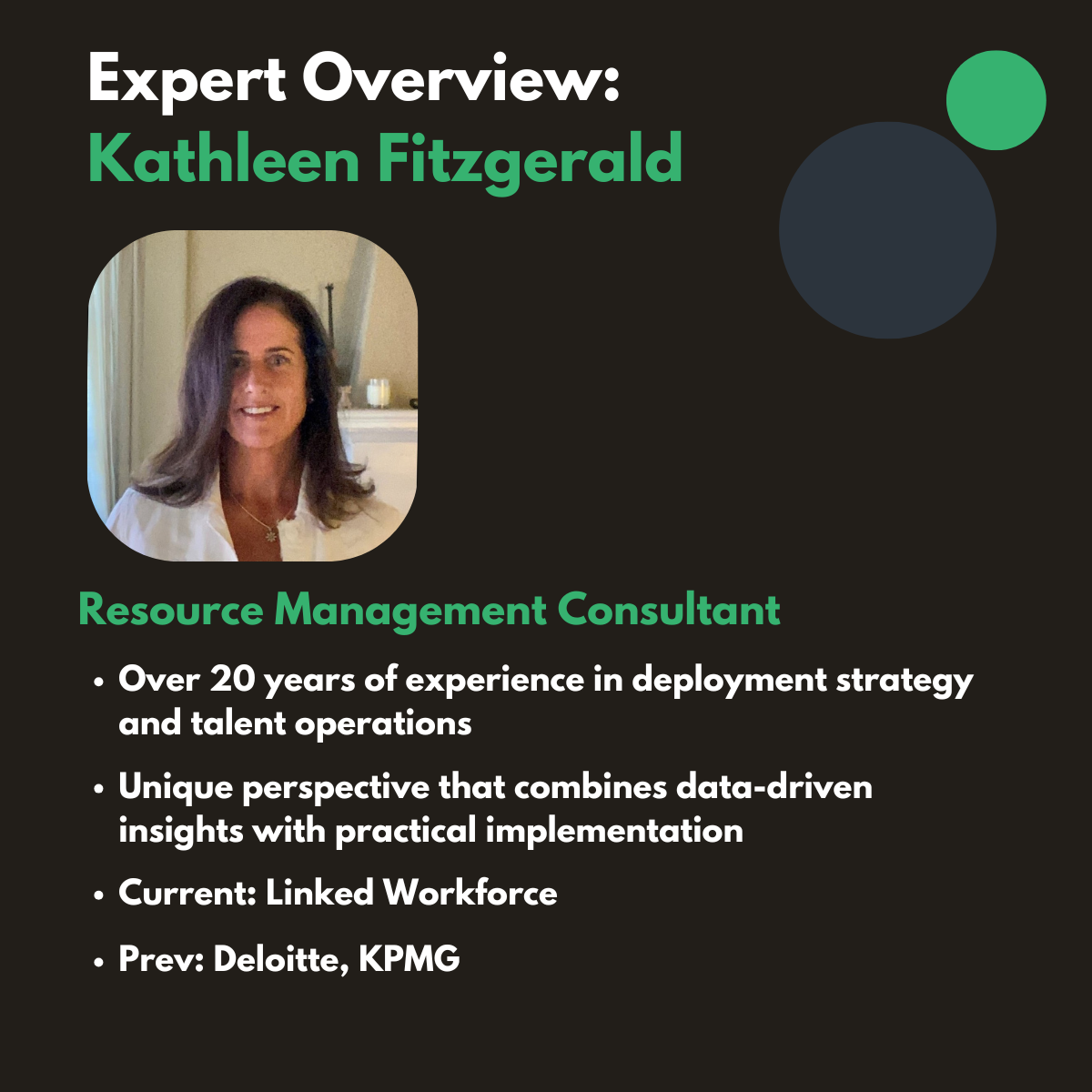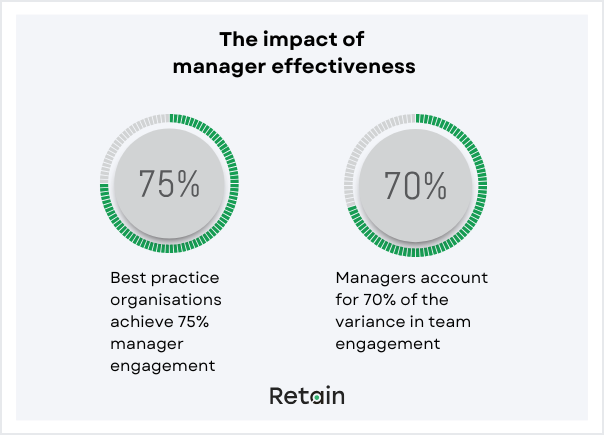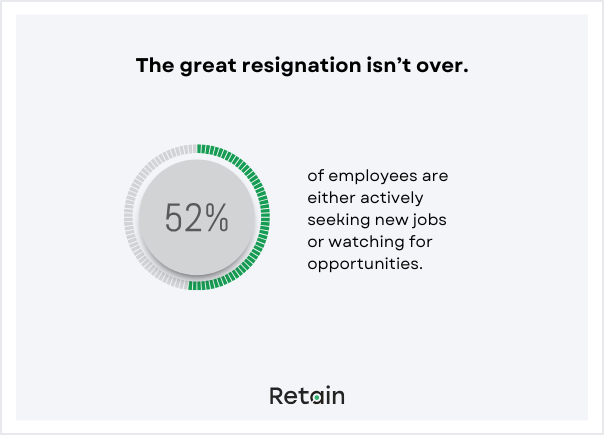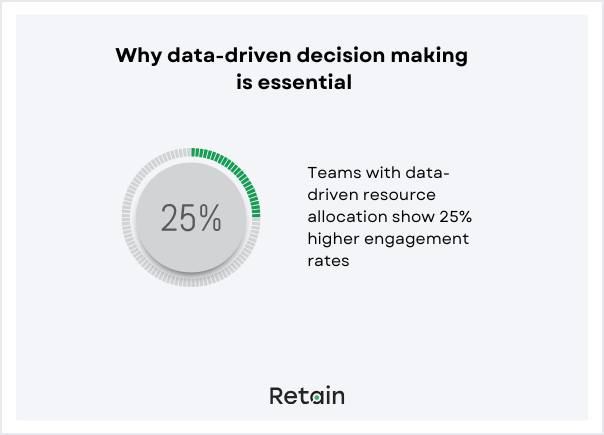According to Gallup’s 2024 State of the Global Workplace report global employee engagement sits at just 23%, costing organisations £8.9 trillion annually in lost productivity. That's 9% of global GDP slipping through the cracks of disengaged workforces.
You know what this means for resource management. Every project deadline, team allocation and skill deployment directly impacts these figures. And with 52% of employees actively looking for new opportunities, the pressure to get it right has never been higher.
Of course, understanding global trends is one thing. Turning them into practical improvements is another. That's why we have analysed the data to bring you five essential takeaways, with actionable steps you can implement today.
Meet our expert: Kathleen Fitzgerald

To provide additional context to these workplace trends, we talked to Linked Workforce’s Kathleen Fitzgerald, an independent workforce planning expert, for her views. With more than 20 years of experience in deployment strategy and talent operations, Kathleen offers valuable perspective on how organisations can respond to these emerging trends.
"When Retain approached me to share my views on these workplace trends, I was keen to contribute," says Fitzgerald. "The data from Gallup aligns with what I'm seeing across organisations - resource managers need better ways to address these challenges."
Now, let's take a look at the five critical trends identified from Gallup's latest research...
1. The engagement crisis is costing organisations more than ever
The global engagement crisis isn't just about unhappy employees. It's about your bottom line. When Gallup reveals that disengaged employees cost organisations £8.9 trillion annually, that translates to real losses in productivity, innovation and client satisfaction.
"What's particularly concerning is that only one in four employees feel truly connected to their work," notes Kathleen Fitzgerald. "But here's what resource managers often miss: this isn't just a HR problem—it's a resource allocation challenge."
The real cost to your organisation
The numbers tell an interesting story:
- 62% of employees are 'not engaged'—putting in time but not energy or passion
- 15% are 'actively disengaged'—potentially undermining team success
- Best-practice organisations achieve 70% higher engagement rates through effective resource management

You might be thinking these figures don't apply to your team. But here's the reality: even high-performing organisations are leaving money on the table through suboptimal resource allocation.
Why traditional approaches fall short
Standard resource management methods often fail because they:
- Focus on availability rather than engagement
- Ignore skill development opportunities
- Miss crucial data about team dynamics
- Lack real-time visibility into resource utilisation
"The organisations seeing the best results are those using data-driven resource management platforms," Fitzgerald explains. "They're three times more likely to spot engagement issues before they impact project delivery."
How modern solutions bridge the gap
Smart resource management platforms like Retain help you:
- Match people with projects that align with their skills and career goals
- Monitor team workload in real time to prevent burnout
- Use AI-powered analytics to optimise resource allocation
- Track engagement metrics alongside project performance
2. Remote work is changing team dynamics
Here's a surprising finding from Gallup's research: remote workers show higher engagement (29%) than their on-site counterparts (20%). Yet they're also experiencing higher rates of loneliness, with 25% reporting daily isolation compared to 16% of on-site workers.

"These contradictory findings highlight a crucial challenge for resource management," says Kathleen Fitzgerald. "We're seeing teams with high individual productivity but weakening social connections. That's a serious risk for long-term project success."
The hidden costs of poor remote resource management
Let's look at what ineffective remote team management really costs:
- Lower collaboration quality due to disconnected team members
- Increased project delays from communication breakdowns
- Higher turnover as isolated team members seek new opportunities
- Missed development opportunities due to reduced visibility
Of course, it's not all doom and gloom. Some organisations are turning these challenges into opportunities.
What successful teams do differently
Top-performing organisations achieve better results by:
- Balancing workload across time zones
- Creating virtual collaboration opportunities
- Ensuring fair project distribution between remote and on-site staff
- Maintaining clear visibility of team capacity regardless of location
"The difference between successful and struggling organisations often comes down to their resource management tools," Fitzgerald notes. "Companies using integrated platforms, report 40% better collaboration scores across hybrid teams."
Solutions for modern ways of working
This is where platforms like Retain make a real difference:
- Real-time visibility across all team members, regardless of location
- Smart scheduling that accounts for time zones and working patterns
- Built-in communication tools that integrate with existing systems
- Automated capacity planning that prevents remote worker overload
3. Manager effectiveness is make-or-break
Let's cut to the chase: managers account for 70% of the variance in team engagement. That's not a typo. Your managers are either your greatest asset or your biggest liability in the fight for employee engagement.
"Most organisations vastly underestimate the impact of poor resource management tools on their managers," Kathleen Fitzgerald points out. "When managers spend 60% of their time on admin tasks, they're not focusing on what really drives profit."
The manager paradox
Here's what makes this particularly challenging:
- Managers report higher stress levels than individual contributors
- They're more likely to be actively job hunting
- Yet they're expected to boost team engagement and productivity
- Best-practice organisations achieve 75% manager engagement (compared to the global average of 30%)

Naturally, you're wondering how top organisations achieve such high manager engagement rates.
What sets top-performing managers apart
The difference comes down to having the right tools and support:
- Clear visibility of team capacity and skills
- Automated scheduling and resource allocation
- Real-time analytics for decision-making
- Simplified approval workflows
"The organisations seeing the best results have shifted their managers from resource administrators to strategic team leaders," explains Fitzgerald. "They've done this by automating the mundane and providing better insights for decision-making."
Technology as the manager's ally
Modern resource management platforms like Retain help managers:
- Reduce administrative burden by up to 40%
- Make data-driven decisions about resource allocation
- Identify skill gaps and talent management opportunities
- Monitor team wellbeing through workload analytics
4. The great resignation isn't over
Here's a hard stat to ignore: 52% of employees are either actively seeking new jobs or watching for opportunities. That's more than half your workforce with one foot out the door. But there's an interesting twist in the data.

"The correlation between job markets and disengagement is really interesting," says Kathleen Fitzgerald. "In regions with strong job markets, we see lower active disengagement. People aren't trapped in roles they dislike—they're choosing to stay. That's a key distinction for resource management."
The hidden patterns in employee retention
The Gallup data reveals some key trends:
- Better job markets correlate with lower active disengagement
- Career growth opportunities remain the top retention factor
- Regions with high labour mobility show better engagement scores
- Skill development access directly impacts retention rates
Of course, this presents both challenges and opportunities for resource management.
Why traditional retention strategies fall short
Common approaches often miss the mark because they:
- Focus on compensation rather than career development
- Ignore the importance of skill utilisation
- Lack of visibility into employee aspirations
- Miss early warning signs of disengagement
"Smart organisations are treating retention as a resource optimisation challenge," Fitzgerald notes. "When you match people with projects that develop their skills, you naturally improve retention."
Modern solutions for retention
Here's how platforms like Retain help tackle the retention challenge:
- Track and match skills with development opportunities
- Provide clear visibility of career progression paths
- Enable fair distribution of challenging projects
- Monitor engagement through workload and utilisation reports
5. Data-driven decision making is essential
Let's talk about what really separates top-performing organisations from the rest. The Gallup data shows a clear pattern: organisations using integrated analytics and real-time insights achieve significantly better outcomes across all engagement metrics.
"There's a direct correlation between data visibility and resource optimisation," explains Kathleen Fitzgerald. "When resource managers can access real-time analytics, we see up to 40% improvement in resource utilisation and a 35% reduction in project delays."

The true value of resource intelligence
The numbers tell an interesting story:
- Best-practice organisations are three times more likely to spot potential issues before they impact projects
- Teams with data-driven resource allocation show 25% higher engagement rates
- Real-time analytics reduce resource conflicts by up to 60%
- Predictive planning reduces bench time by 30%
Naturally, achieving these results requires the right tools and approach.
Why gut instinct no longer cuts it
Traditional resource management falls short because:
- Manual tracking can't keep pace with rapid changes
- Spreadsheets don't provide predictive insights
- Siloed data leads to incomplete decision-making
- Historical reporting doesn't support proactive management
"The organisations seeing the best results have moved beyond basic resource tracking," Fitzgerald notes. "They're using predictive analytics to make proactive decisions about resource allocation."
Transform data into action
Modern platforms like Retain help you:
- Access real-time dashboards for immediate insights
- Use AI-powered analytics for resource forecasting
- Track key metrics through integrated Power BI reporting
- Make data-driven decisions about capacity planning
Taking the next step
The evidence is clear: organisations that use data-driven resource management are pulling ahead of their competitors. But knowing where to start can be challenging.
Ready to see how your organisation measures up? Book a consultation with our team to get your free assessment and discover how Retain can transform your resource management approach.
Want more insights on resource planning and optimisation? Subscribe to our newsletter for regular updates and expert tips.


